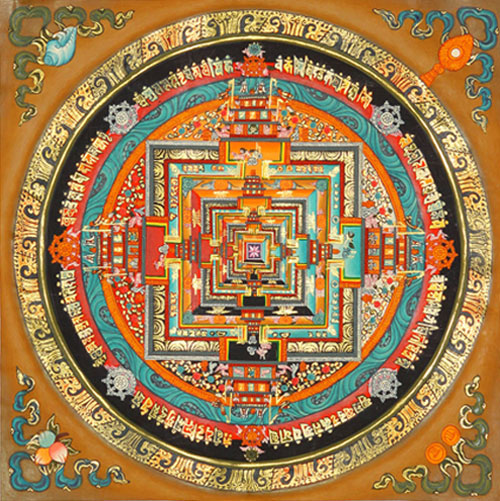Mandalas: how the sacred circle helps us reconnect with ourselves
They’re omnipresent, cryptic and alluring… but what really are mandalas?
The mandala is one of the most ancient and universal symbols known to man. Meaning “circle” in Sanskrit, the mandala can be found everywhere from Palaeolithic engravings, to medieval alchemy and Tibetan Buddhism.

Mandala Meaning
At the most basic level, mandalas represent wholeness, unity and harmony. However, every mandala has a unique meaning. Throughout the world, mandalas have come to portray everything from psychological balance (Jungian psychology) and cosmic order (Taoism), to religious beliefs (Christianity) and the impermanence of life (Navajo Indians).
Father of analytical psychology, Carl Jung, himself drew mandalas to aid his self-growth. Every morning he would sketch a circle in his notebook, and within it he would draw what he felt reflected his inner situation. As he wrote in his autobiography: “Only gradually did I discover what the mandala is… and that is the self, the wholeness of the personality, which if all goes well is harmonious.”
However, Jung’s interpretation of the mandala is only one of many interpretations. In Tibet, for example, mandalas are created as meditation aids for the Buddhist monks who design them. In Islam, mandalas are created purely for devotional purposes, and in Celtic paganism, the mandala represents the three worlds of body, mind and spirit.
Clearly, regardless of their meaning, mandalas have always embodied that which is sacred, holy and mystical. It seems that despite our cultural or religious context, mandalas have a universal appeal to our human psyche.
How to Draw Your Own Mandala
“Awareness of the mandala may have the potential of transforming how we see ourselves, our planet, and perhaps even our own life purpose.” — Bailey Cunningham.
Learning how to draw your own mandala is a deeply absorbing, meditative practice. Not only does it unleash your inner artist, but creating your own mandala meaning can produce deeper insights about life itself.
Designing your own mandala is a beautiful way of entering a beneficial new state of consciousness. Benefits include an increased sense of wellbeing, calmness, clarity, emotional stability, wholeness, creativity and understanding. Mandalas are also said to carry their own special kind of vibrational energy. Therefore, they can be used for the enhancement of mental, emotional, physical and spiritual health.
Before you create your mandala you will need a few materials:
• A piece of paper or visual diary.
• Pencil, permanent marker and eraser.
• Optional: ruler, compass and protractor for drawing lines and circles (otherwise you can draw them organically by hand).
• Optional: coloring pencils, watercolor paints or oil pastels.
Steps:
1. Get comfortable — find a quiet and undisturbed place where you can relax. Being interrupted might cut your creative flow.
2. Create a purpose — in other words, what is the intent behind your mandala? Do you want to simply express your unconscious, or do you have a more specific intention such as creating a meditation aid? Perhaps you might even want to creatively express feelings such as love or gratitude?
3. Draw whatever comes to mind using a lead pencil that can be freely erased. You might like to use a compass, protractor and ruler… or free-hand draw your designs.
4. Mandalas are all about symmetry, so it helps to split your page into two. Whatever you draw on one side, draw on the other. This creates balance.
5. If “mental chatter” starts, stop, breathe and let it pass. Once you’ve reconnected with your creative flow, you can continue drawing.
Once you’ve finished your mandala, you may like to think about coloring it in. Different colors have different meanings, so choose what colors resonate with your intention. Here are some examples:
• Yellow for joy and happiness.
• Orange for self-awareness and creativity.
• Red for energy, passion and strength.
• Pink for femininity, love and gentleness.
• Violet for insight and intuition.
• Purple for mystery and spirituality.
• Blue for healing and peace.
• Green for nature, groundedness and connection.
• White for purity, truth and consciousness.
Most importantly, your mandala needs to be soulful. Don’t concern yourself too much with making it look “correct” or perfectly symmetrical. We use our analytical left-sided brains too much in daily life! Let your mandala art be free-flowing. This way you’ll enjoy creating it much more and it won’t be a source of perfectionism or stress for you.
Here is a short instructional video:
The mandala meaning varies from culture to culture. What is evident is that the sacred circle has been apparent in nature, religious art and spiritual rituals since the dawn of time. Circles will always be symbolic of oneness and thus appeal to our deeper understanding of truth, completion and joy.
yogaesoteric
July 29, 2019
